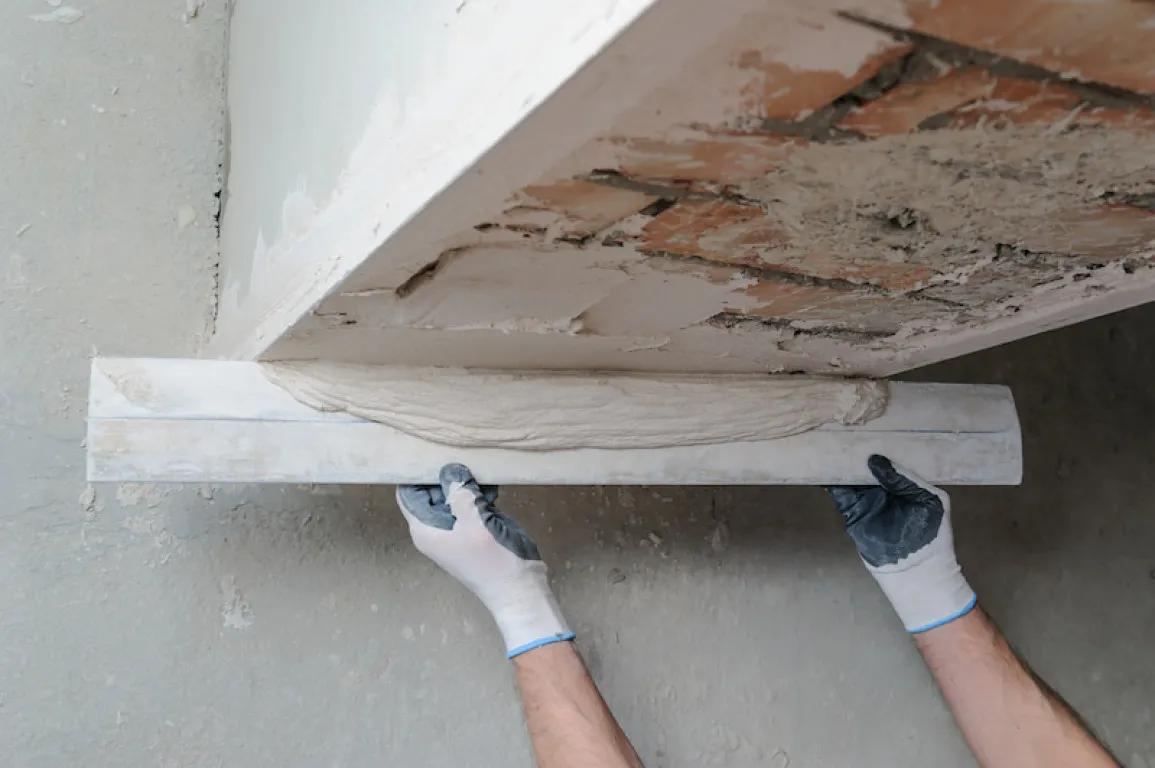Gypsum is a building material derived from a natural mineral and plays an important role in the construction industry due to its versatile properties. This material is commonly used in the creation of ceilings, bathroom walls, and as an additive in cement production.
Gypsum comes in various types with different specifications and uses. Therefore, let’s explore more clearly what gypsum is and how this material plays a role in constructing various building structures!
What Is Gypsum?
Gypsum is a natural mineral formed from hydrated calcium sulfate. This material is often used for making ceilings, bathroom walls, and as an additive to cement raw materials. In addition, gypsum also has several special characteristics, including:
- Lightweight.
- Fire-resistant.
- Has good rigidity.
- Can reduce sound reflection.
- Resistant to chemical attacks.
- Effective in moisture control.
- Contains a large amount of crystal water.
Functions of Gypsum for Buildings
Gypsum is one of the most versatile construction materials as it can be used in various building applications. To clarify further, here are the functions of gypsum for buildings:
1. Ceiling Construction Material
First, this material can be used as a ceiling, which is commonly used for residential ceiling construction. In addition to its strong, smooth, and flat properties, gypsum ceilings are also more effective in preventing leaks compared to other materials.
With its sheet form, this material also simplifies and speeds up the installation process, making it practical and efficient for modern construction needs.
2. Wall Coating Material
Another key function of gypsum is as a wall coating material, particularly in spaces like bathrooms. Its ability to resist water and withstand impact makes it an ideal choice for such applications. Moreover, gypsum is also easier to shape and install compared to traditional bricks. By using gypsum, you can paint the wall without the need for additional blocks.
3. Binding Material
Gypsum is often used as a binding material in cement, plaster, and mortar mixtures as it has stronger adhesive properties on walls compared to other materials.
This material is generally used in powder form, mixed with water to form a paste, which then hardens into a solid plaster layer. This plaster is then used to level wall surfaces and fill gaps or cracks in the building.
Read also: What Is an Admixture? Learn Its Types and Purposes
4. Home Decoration
Another function of gypsum is for home decoration ornaments. Gypsum can enhance the aesthetics of a room through elements like moldings and ceiling centers. For example, ceilings can be shaped into domes, drop-up ceilings, or other creative designs.
Additionally, gypsum is easy to maintain. If the surface gets dirty or dusty, you don’t need to repaint it, but just wipe it with a damp cloth and dry it off.
5. Partition Panels
Last but not least, gypsum can also be used as a partition panel to divide a single room into several separate areas. These panels are typically made from gypsum combined with other materials like fiber and cardboard. Thanks to its soundproofing properties, the partition not only enhances the room's acoustics but also ensures privacy and comfort for the occupants.
Types of Gypsum
There are various types of gypsum that can be used for your building needs. Each type has different sizes, which also affects its price. For example, thin gypsum is usually more affordable compared to thicker ones. Below are some types of gypsum you can choose from:
1. Regular Gypsum
Regular gypsum is a type of material coated with paper and is commonly used for ceilings in living rooms or other spaces. This material is easy to install using screws, nails, or glue, and is flexible for painting or polishing. Thus, you can customize the ceiling color and appearance based on your preferences.
2. Moisture-Resistant Gypsum
This type of gypsum is coated with wax or silicone to make it waterproof. Therefore, it is ideal for damp areas, such as kitchens, bathrooms, or basements. However, moisture-resistant gypsum is more recommended for walls than ceilings, as it is more effective in resisting moisture exposure.
Read also: 11 Types of Cement and the Functions in the Construction
3. Fire-Resistant Gypsum
In addition to moisture resistance, another type of gypsum has fire-resistant properties. This material is specifically designed to protect against heat and fire by adding fiberglass during the manufacturing process, making it stronger and capable of withstanding high temperatures.
Fire-resistant gypsum is perfect for use in areas such as kitchen walls, around cooking stoves, fireplaces, or outdoor walls that need extra protection against fire risks.
4. Soundproof Gypsum
This type of gypsum is specially designed to reduce noise by absorbing sound, making it highly effective in damping echoes and reverberations in a room.
Soundproof gypsum is often used in spaces that require privacy or quietness, such as bedrooms or music studios. However, this type of gypsum should not be installed in areas with extreme temperatures, as it may affect its durability and material quality.
5. Drywall
Drywall is one of the most popular types of gypsum for walls and ceilings. This type comes in various sizes with smooth surfaces and is easy to finish.
6. Patterned Gypsum
Patterned or textured gypsum has a surface that has specific textures or designs. This material is usually used to enhance the appearance of walls or ceilings, adding attractive and distinctive decorative elements.
7. Perforated Gypsum
Next, there is perforated gypsum, which has small holes and is often used to enhance the ceiling's appearance.
This type of gypsum offers an aesthetic appeal with attractive patterns on the ceiling and improves the room's acoustics by damping sound and reducing echo. If you're looking for a ceiling gypsum that is both aesthetically pleasing and functional, perforated gypsum could be the perfect choice.
8. PVC Laminated Gypsum
PVC laminated gypsum is coated with PVC in various patterns, designed to create a luxurious impression and beautify the appearance of a room. Additionally, this gypsum is easy to maintain and clean, making it practical for use.
Read also: Concrete Grade: Types and Classification Table
9. Aluminum Foil Gypsum
This type of gypsum is coated with aluminum foil, thus providing excellent heat resistance. It is highly suitable for areas or rooms that are frequently exposed to high temperatures as it can effectively withstand heat.
The Advantages and Disadvantages of Gypsum
Just like any other material, gypsum also has both advantages and disadvantages that should be considered. Below are the pros and cons of gypsum you should know:
1. The Advantages of Gypsum
Gypsum is a building material that may seem simple, but it actually comes in various types and specifications. Here are some reasons why gypsum is a popular building material:
- Affordable Price: Helps save budget for various building projects.
- Lightweight: Makes installation easier and reduces the load on the building structure.
- Quick and Easy Installation: Can be installed using screws, nails, or glue, making it a fast process.
- Flexible in Design: Can be shaped into tiered ceilings, domes, or other forms.
- Smooth and Even Finishing: Creates a neat appearance on walls or ceilings.
- Fire and Water Resistant: Some types offer extra protection against fire hazards and moisture.
- Good Acoustics: Certain types of gypsum help dampen sound for a quieter and more comfortable environment.
- Termite Resistant: Not prone to termite attacks, making it more durable and safe to use.
- Widely Available in the Market: No need to worry about finding and choosing the right gypsum material as it is widely distributed.
- Easy Maintenance and Repair: Maintenance is simple, and repairs can be done easily without high costs.
- Environmentally Friendly: Made from abundant natural materials, easy to recycle, and has a low carbon footprint in its production process.
2. The Disadvantages of Gypsum
Although gypsum has many advantages, it also has some drawbacks that you should be aware of from the beginning. By understanding these disadvantages, you can minimize potential risks that may arise in the future. Some disadvantages of gypsum include:
- Not All Types are Waterproof: Some types of gypsum are vulnerable to high humidity and can be damaged if exposed to water for extended periods.
- Prone to Impact Damage: Certain types of gypsum can be easily damaged when exposed to strong impacts.
- Limited Strength: Gypsum is generally used for interior, non-structural purposes due to its limited strength.
- Absorbs Moisture: In environments with high humidity, gypsum can absorb moisture from the air, which may reduce its durability.
Gypsum Installation Process
Installing gypsum for building purposes requires specific skills and the right tools to ensure optimal results. If you want to install it, make sure to follow these general steps:
- Ensure that the surface where the gypsum will be installed is flat, dry, and free from dust, dirt, or oil.
- Install the supporting frame on the wall or ceiling using appropriate materials and tools. Make sure the frame is sturdy and does not shift.
- Place the gypsum board onto the frame and secure it using screws or special nails. Ensure that the joints between the boards are tightly sealed to avoid air or sound leakage.
- After installation, perform finishing tasks such as jointing and painting according to the desired design, ensuring that the seams and holes on the gypsum surface are well hidden.
- Install additional accessories like moldings, cornices, or decorative elements according to the design and project needs.
From the explanation above, it can be concluded that gypsum is a highly important and versatile building material in the construction industry. With its various types, advantages, benefits, and ease of installation, it has become the primary choice for creating safe, comfortable, and aesthetic spaces.
In addition, to optimize the strength and durability of the overall building structure, you can use Semen Merah Putih. Semen Merah Putih offers a range of high-quality cement products, such as Semen Merah Putih Watershield, which provides triple protection and ensures buildings are stronger, more durable, and require less maintenance.
Semen Merah Putih continues to innovate with the latest technologies as part of our commitment to supporting sustainable infrastructure development in Indonesia. Contact us now for more information about Semen Merah Putih and other products!
Read also: Types of Deep and Shallow Foundations for Buildings



